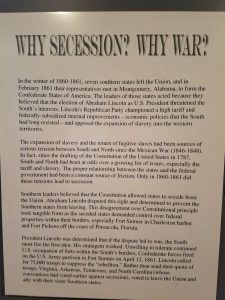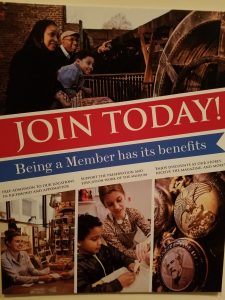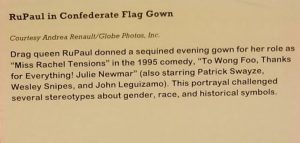by Joshua Kim
Picture this. You, an innocent, pop-culture savvy, Korean-American student at the University of Richmond, exploring the Museum of the Confederacy. You read the sign in the entrance:
“The leaders of those states acted because they believed that the election of Abraham Lincoln as U.S. President threatened the South’s interests. Lincoln’s Republican Party…opposed the expansion of slavery into the western territories. The expansion of slavery and the return of fugitive slaves had been sources of serious tension between South and North since the Mexican War (1846-1848). …Only in 1860-1861 did those tensions lead to secession.”
Cool. Awesome. Sweet. You feel reassured that the museum will be inclusive of those who were enslaved by white-colonial Americans, aka Africans. So you begin your self-led tour of the museum.
1, 2, 3, 4, 5, 6?
Around six pictures of Black people, including the advertisement to become a member of the museum’s club, found in this three-level building. Six.
The photo on the left — advertising museum membership — was actually the first photo of Black people I found in the museum. It rests on the second floor
This has to be a mistake.
After spending weeks working with the Race & Racism at the University of Richmond Project — weeks of investigative archival work, of searching against the grain to illuminate the stories of minority students on campus — you find only five or six pictures of Black people in the Museum of the Confederacy. A museum dedicated to the history of the Confederate South, which enslaved thousands upon thousands of Africans–only five or six images of Black people, and only half of them actual enslaved people.
And then you see RuPaul.
RuPaul is an actor, television personality, singer, and perhaps most notably, one of the most well-known drag queens in the world. RuPaul’s accolades include 11 studio albums, numerous television and movie appearances, and his show RuPaul’s Drag Race , which won a Primetime Emmy Award in 2016.
So why was RuPaul in the Museum of the Confederacy? Because he was garbed head-to-toe in a glamorous Confederate-flag dress.
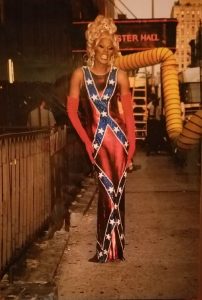
As surprising as it was to see RuPaul in the Museum of the Confederacy, it made sense. RuPaul wore that dress in the movie, To Wong Foo, Thanks for Everything! Julie Newmar (1995), where he played the character of — yes, you guessed it — a drag queen. At its simplest, the film could be interpreted as social commentary on masculinity, women’s empowerment, and most importantly the cultures of drag and the South.
There are many interpretations as to why RuPaul wore this dress, but many critics have come to agree that it was most certainly a political statement. RuPaul — a Black, queer, drag queen–wearing a Confederate flag dress could only mean one thing: f&^% you, Confederacy. (People actually were offended by her wearing the dress, too).
Quite frankly, that was my interpretation as well.
When I saw the photo, it screamed “SHADE. READ. DRAG HUH.” (Shade – casual, subtle yet obvious insult. Read – educated, well thought out insult/joke, typically used as an underhanded compliment. Drag – an insult, overt).
Until I read the caption:
“Drag queen RuPaul donned a sequined evening gown for her role as “Miss Rachel Tensions” in the 1995 comedy, ‘To Wong Foo, Thanks for Everything! Julie Newmar’ (also starring Patrick Swayze, Wesley Snipes, and John Leguizamo). This portrayal challenged several stereotypes about gender, race, and historical symbols.”
I do not know the intentions of whoever wrote this caption, but what I do know is that this caption is very misleading. To anyone who knows nothing about drag, the caption leads you to believe that RuPaul was somehow trying humanize the Confederacy.
“Look at this black, queer drag queen wearing this historical symbol! Told you it wasn’t racist.”
Drag is political.
RuPaul wearing a glamorous Confederate flag dress was not an attempt to praise the flag from an outside perspective, but rather as a way to diminish its value; to use his outsider status to diminish the sentiment behind the flag.
To many people, the Confederate flag is a symbol of pride and heritage — one that leaves out a history of enslavement in favor of sweet tea and Chevy trucks. So, for this queer, Black drag queen to wear this dress is to make a statement; what does it mean when an outsider to Confederate culture chooses to wear the dress in such a queer, black fashion?
Heresy. Pure, utter heresy. And that’s not just me who thinks that:
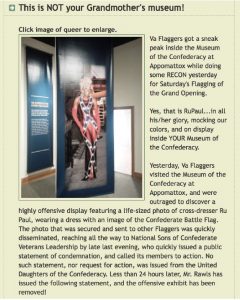
Heritage, not hate?
All in all, I was quite disappointed with the way the Museum of the Confederacy chose to curate its site. It is 2017. Come on. It’s about damn time to finally include enslaved Africans into the history of the Confederacy. I want to see those who resisted, those who assimilated, even those who did nothing! I just want to finally see a Confederate history that’s not, well, so white.
In conclusion, I end this post with the words of RuPaul himself:
Museum of the Confederacy, Sashay, Away.
Joshua Hasulchan Kim is from Colonial Heights, Virginia. He is a sophomore at the University of Richmond who is double majoring in Journalism and French. Joshua is involved in various clubs on campus: He is the co-president of Block Crew dance crew, the opinions editor for the Collegiannewspaper, and is the Co-Director of Operations for the Multicultural Lounge Building Committee. Joshua joined the project as part of the Spring 2017 independent study (RHCS 387) and is currently expanding this research with the support of an A&S Summer Research Fellowship.

